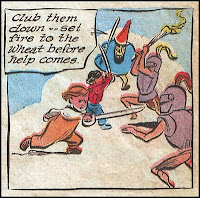You can hear our conversation over here.
We wanted to have a Halloween-y type-show because AM1690 is sponsoring a showing of Hitchcock's Psycho at the Plaza Theater around the corner on Ponce.


But also, mysteriously paintings from an unknown "Royce Riley" showed up at the Righteous Room (also on the corner with the Plaza Theater and Zac's realty). No big thing that the Righteous Room would have paintings, but look at them:
It's hard not to think that Royce Riley is R. Land's doppelganger, how unheimlich. So there's this spooky double out there, also involved in painting, also hangin' out on Land's block, but if we look at many of the characters that Land creates they seem to be in perpetual shudder or trembling. These involuntary movements, called dystonia, is a strong indicator of neurodegenerative diseases in both Parkinson's and Huntington's Diseases. Spooky.
But I also wanted to talk about R. Land as a painter that seems to capture a lot of the bizarre charm of being from the Southeast and also being in these times.
Though a longtime Atlantan, he's from Jacksonville, Florida. When we look at some of his contemporary paintings, like Itchitucknee Songbook (2008) that I mentioned in the talk with Jeremy, we begin to suss some of that Southern-ness out.
When I look at Itchitucknee Songbook (right) I see something quintessentially lowcountry. The lowcountry is a term used primarily to describe the coastal regions of South Carolina but the geography is fairly consistent from Wilmington to Jacksonville/St. Augustine. It's called the Coastal Empire in Georgia and it's called the First Coast in northeast Florida.
What's consistent in the region are the marshes. But also, a fascinating group called the Geechee-Gullah. These folks are thought to be descended from the earliest African slaves brought to Charleston, South Carolina via Brazil. Because the lowcountry and coastal empire region shares a semitropical environment, yellow fever out breaks were frequent and often the white slave owners would leave the slaves for extended periods of time to work. This physical distance in turn allowed a growing cultural difference between the Gullah and the mainland African slaves. While Gullah communities are largely isolated still, contact can be achieved via folkstories that some children are taught in the region. The folkways of the region have developed, of course, in tandem. While the Wren's Nest talks about Joel Chandler Harris and his popularizing of Uncle Remus, those of us from the Gullah region also learned about Bruh Rabbit (not Br'er Rabbit like in Disney's Song of the South).
 |
| Silhouette by Carew Rice to illustrate a collection of Gullah poetry called Dusky Land (1942) |
From the Gullah we get also the spiritual, "Michael Row Your Boat Ashore" and the Itchitucknee Songbook also evokes for us the old-timey "Swanee River" that Gershwin made famous via Al Jolson - the Ichetucknee River flows into the Suwanee on its way to the Gulf of Mexico. The source of the Suwanee is that incredible Okefenokee Swamp. Which is, of course, the home of that lovable comic strip by Walt Kelly, Pogo.
 |
| from the Pogo Primer for Parents, a U.S. Government document, 1961 |
But have you seen some of the wildlife in the region?
 |
| catfish - they get enormous! |
 |
| mermaid fishing in Rainbow Springs, Florida (where Zaat was filmed) |
 |
| are you telling me these manatees are not kinda abject and surreal |
The color palette that R. Land uses is fairly typical of comic books, such as the Walt Kelly I've already mentioned but also the ubiquitous Bazooka Joe comics that we read as kids when walking to the Circle K.
But these colors are also found in the early maps of the First Coast region as well:
 |
| map of St. Augustine, British East Florida. Thomas Jeffrey (1763) |
 |
| Sir Francis Drake lays siege to St. Augustine. Baptista Boazio (1589) |
Of course, R. Land also evokes some of his contemporaries such as Reverend Howard Finster (outsider/folk artist par excellence here in Atlanta):
 |
| Coke Bottle. Howard Finster (2001) |
 |
| Untitled. Mural in Pisa, Italy. Keith Haring (1987) |
And this influence can't be played down as we see the repetition of iconic figures in something like "Lacoste Landfill" (Izod), 2008:
Yes, it's a funny appropriation of a global capital icon. But, if we look back to the image records of the region where R. Land is from we see that there is also an historical precedent for seeing in this way that is no less surreal (if we mean it in the Breton manner of becoming "scientists of sleep"):
 |
| Crocodile Hunt. Jacques Le Moyne (16th century) |
 |
| Crocodile Hunt. Jacques Le Moyne (16th century) |
 |
| Chief Saturiwa. Theodor de Bry (engraving based on Jacques Le Moyne), 16th century |
 |
| Timucua owl totem. Pre-Columbian era |
 |
| Untitled (Owls) R.Land (2008) |












I am so pleased I found this blog, I really got you by an accident, while I was searching for something else. The story and blog you have published is very interesting as well as informatics, Thanks for sharing such type of informatics thing.
ReplyDeleteHere is some useful information too
DRU Fires
Gazco Gas Fire
Zehnder Designer Radiators
Reina Designer Radiators
Bosch Home Appliances
Franke Kitchen Sinks
Neff Kitchen Appliances
Aeon Designer Radiators
Bisque Designer Radiators
Manhattan Shower Enclosures
Blanco Kitchen Appliances
Matki Bathrooms
Royce Morgan Baths
HIB Quality Bathroom Products
Hudson Reed Bathrooms
Premier Baths
Vitra Baths
Phoenix Baths
RAK Ceramics
Hansgrohe Baths
Roca Baths
Portable Cloud Storage Apps are light software versions that can be run from a USB drive without being installed on the computer. Download Portable Apps at archive-box.com
ReplyDeletePortable Apps, Cloud Storage App, Dropbox Portable App, File Manager App, Online File Manager, Online Storage App, Online Data Storage, Online Data Backup, Portable Cloud Storage App, Portable Archivebox
Thanks